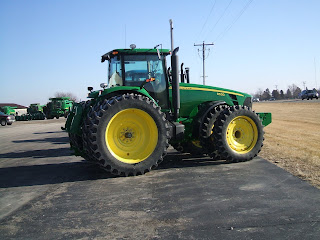Before I started this blog I had several on-line converstation with people who asked questions about commercial fertilizer, organic crops and modern agriculture. Now I work on a farm where most of the latest and best agriculture practices are used. Some, maybe even most are related to large scale production, this does not make them wrong, it simply means that the goal of this operation is to produce as many bushels of corn and beans as possible with the lowest possible amount of inputs(costs). Nothing is done that will not show a financial return. Money is not spent on needless trips across the fields, or spraying chemical just to make the paranoid enviromentalist/luddites have a hissy fit.
I would be glad to expand on that paragraph. If you have questions, I'll try to answer, but the post tonight is about the effects of commercial fertilizer. Someone questioned why put good money in the ground by putting on anhydrous ammonia(NH3), as I showed pictures of in a previous post. One of the most important nutrients necessary for growing corn. Without the nitrogen the corn plant is pale almost yellow, it is stunted in height, and most importantly without nitrogen during the pre pollination stage, the corn plant is already determining ear length and the number of rows of kernals. Without nitrogen those things will be considerably smaller, leading directly to reduced yields. And since high yields are the goal, having all the nitrogen available to the plant when it needs it is critical.
The following picture is an excellent illustration of this lack of nitrogen effect. One of the tool bars shown in that previous post, had a plugged knife,(three different operators, none of us noticed the the knife was not working correctly) the part which goes into the ground, injecting the NH3 into the soil. As a result, each pass made with the toolbar left a streak in the field where little or no NH3 was applied. As you can see in the picture, the corn is yellow, stunted (a foot shorter) and generally unhealthy compared to the field around it. A dark green plant, with high levels of chlorophyll is going to be much more effective in the photosynthesis process, turning the energy of the sun, into grain. This particular field was corn on corn, so there was little nitrogen left from the previous year,(remember soybeans add nitrogen back to the soil). On the fields which were corn on beans this streak is not noticable. 
On Saturday we went to southern Iowa to see that new baby. It was good to see everybody again. Got to be there on my parents 45th wedding anniversery. I have a couple of pictures from down in the hill country of southern Iowa. Some people have the mistaken notion that Iowa is all flat as a board, with nothing but corn and bean fields interupted by the occasional hog building. Not where I grew up. This is some timber land on the home farm. 
Before the summer is over I intend to take my family camping in that timber, as well as any other friends who are tough enough not to have to sleep in a house on wheels. We are going to rough it for a couple of nights, no running water, no electricty and no TV. The next picture is standing in roughly the same spot looking the other direction at a huge old oak tree. The tires in the foreground were used at several church youth outtings sponsored by my younger brother for games, like roll the tire race, run through the tire race, stack the tires over the little kid (just joking). 
This last picture I am especially proud of. My second daughter, one of the twins, took this one at dusk, looking west from our yard. We gave her the digital camera for Christmas, and she is beginning to show some real talent in the photography field. I let the kids read the comments ya'll make, so if you like it, say something and she'll see it. Can you see the firefly in the middle?
Monday, July 2, 2007
Nitrogen for growing corn.
Posted by
farmer Tom
at
5:43 PM
![]()
Subscribe to:
Comment Feed (RSS)


|